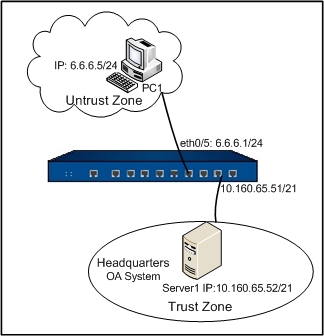URL Redirect Configuration Example
This section describes an URL redirect configuration example.
An enterprise runs an OA system, and Hillstone device works as the SCVPN server. It is required to log on to both the SCVPN and OA system at one time.
This requirement can be met by the URL redirect function. The topology is shown as below:

Take the following steps:
Step 1: Create local users.
- Select Objects > Local User from the menu bar.
- Select local from the Local server drop-down list. Click New > User. In the User Configuration dialog, configure the options as below:
- Name: test
- Password: test
- Confirm password: test
- Click OK to save the settings.
Step 2: Configure the SCVPN address pool.
- On the Navigation pane, click Configure > Network > SSL VPN to visit the SSL VPN page.
- On the Task tab in the right auxiliary pane, click Address Pool to visit the Address pool page.
- Click New. On the Basic tab in the Address Pool Configuration dialog, configure the options as below:
- Name: pool1
- Start IP: 20.1.1.1
- End IP: 20.1.1.100
- Netmask: 255.255.255.0
- DNS1: 20.1.1.3
- WINS1: 20.1.1.2
- Click OK to save the settings.
Step 3: Create the tunnel interface (the IP address of the tunnel interface must be in the same network segment with the address pool).
- On the Navigation pane, click Configure > Network > Network to visit the Network page.
- Click New on the upper-left of the zone list. In the Zone Configuration dialog, configure the options as below:
- Name: VPN
- Type: Layer 3 zone
- Click OK to save the settings and return to the Network page.
- Click New > Tunnel Interface on the upper-left of the interface list. On the General tab in the Interface Configuration dialog, configure the options as below:
- Name: tunnel1
- Binding zone: Layer 3 zone
- Zone: VPN
- Type: Static IP
- IP address: 20.1.1.101
- Netmask: 24
- Click OK to save the settings.
Step 4: Configure SCVPN server.
- On the Navigation pane, click Configure > Network > SSL VPN to visit the SSL VPN page.
- Click New.
- In the Welcome page of the SSL VPN Configuration dialog, Type ssl1 into the SSL VPN name box.
- Click Next. In the User page, select local from the AAA server drop-down list, and then click Add.
- Click Next. In the Interface page, configure the options as below:
- Interface 1: ethernet0/5
- Service port: 4433
- Tunnel interface: tunnel1
- Address pool: pool1
- Click Next. In the Policy/Route page, type 10.160.64.0 and 255.255.248.0 into the IP and Netmask boxes respectively, and then click Add.
- Click Advanced, and in the Client/USB KEY page, configure the options as below:
- Redirect URL: http://192.10.5.201/oa/ login.do?username=$USER&password=$PWD
- English title: OA
- Click OK to save the settings.
Step 5: Edit the policy rule from VPN to Any.
- On the Navigation pane, click Configure > Security > Policy to visit the Policy page.
- Select VPN and Any from the Src zone and Dst zone drop-down list respectively. Select the filtered policy rule, and click Edit. In the Policy Configuration dialog, modify Dst zone from Any to trust.
- Click OK to save the changes.
Step 6: In the web browser of PC1, visit https://6.6.6.1:4433, and in the login page, type test and test into the Username and Password boxes respectively. After the authentication, download and install Secure Connect.
Step 7: After logging in with Secure Connect, the page will be redirected to the OA system authentication page.

